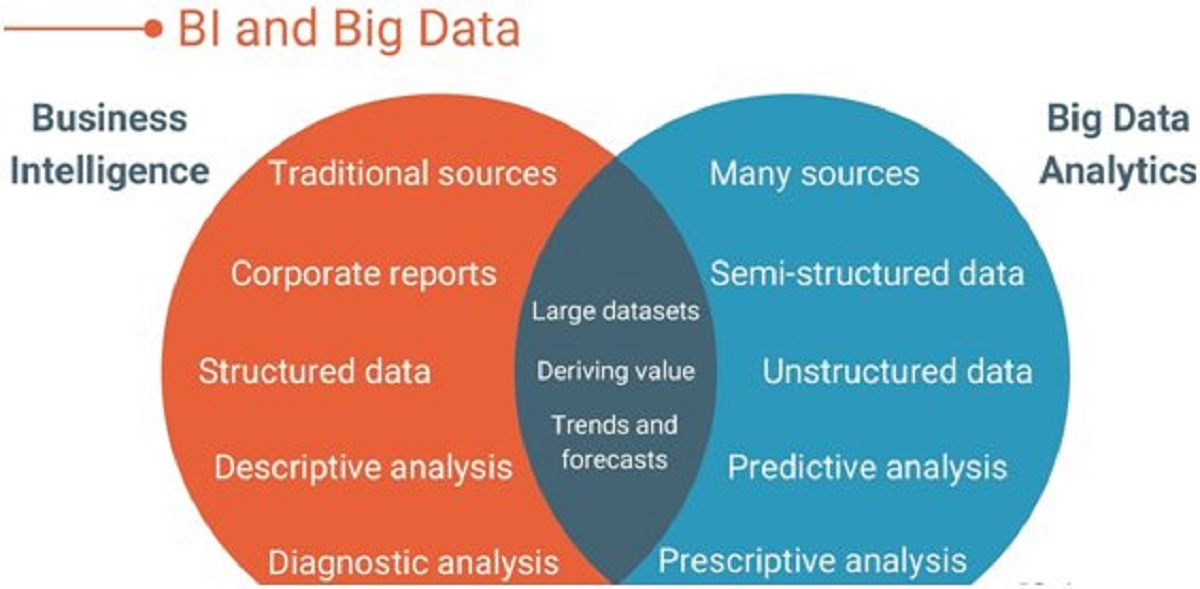Introduction
The widespread adoption of technology has ushered in a new era of data-driven decision making in various industries, and retail is no exception. With the advent of e-commerce and the rise of online shopping, retailers have access to vast amounts of data that can be leveraged to gain valuable insights and drive business growth. Walmart, the retail giant, is at the forefront of this data revolution, utilizing big data to optimize its operations and enhance its customer experience.
Big data refers to the vast amount of structured and unstructured data generated from diverse sources, such as sales transactions, customer interactions, social media, and supply chain operations. This data is characterized by its volume, velocity, and variety, making it too complex for traditional data processing methods to handle. However, with advancements in technology and data analytics, businesses can now harness the power of big data to derive actionable insights and make data-driven decisions.
Walmart, with its massive customer base and extensive supply chain network, generates an enormous amount of data on a daily basis. By strategically collecting, storing, and analyzing this data, Walmart is able to gain a competitive edge, improve operational efficiency, and deliver personalized experiences to its customers.
In this article, we will explore how Walmart collects, processes, and utilizes big data across various aspects of its operations. We will examine the data sources used by Walmart, delve into its data storage and processing capabilities, and highlight some of the key applications of big data in inventory management, supply chain optimization, customer personalization, pricing, and fraud detection.
Furthermore, we will also discuss the challenges and ethical considerations associated with the use of big data in retail, as concerns around data privacy and security continue to grow.
Overall, Walmart’s use of big data demonstrates the immense power and potential of data analytics in transforming the retail industry. By leveraging the insights derived from big data, Walmart is able to make informed business decisions, enhance customer experiences, and maintain its position as a leader in the market.
What is Big Data?
Big data refers to the vast amount of data that is generated from various sources, both structured and unstructured. It encompasses the volume, velocity, and variety of data and includes information from customer transactions, social media interactions, sensor readings, and more. The term “big data” is derived from the immense size of datasets that cannot be easily managed or processed using traditional data processing methods.
There are three key characteristics of big data:
- Volume: Big data is characterized by the massive amount of information generated. With the proliferation of digital technologies and the interconnected world we live in, data is being created at an unprecedented rate. This includes everything from website clicks and social media posts to financial transactions and sensor readings. The sheer volume of data presents unique challenges in terms of storage, management, and analysis.
- Velocity: The velocity of data refers to the speed at which it is generated. Real-time data is becoming increasingly important for businesses to make timely and informed decisions. With the advent of the Internet of Things (IoT) and the proliferation of connected devices, data streams in at high speeds, requiring efficient processing and analysis to extract meaningful insights.
- Variety: Big data is not just limited to structured data, such as numbers and categories. It also includes unstructured data, such as text, images, and videos. The variety of data sources adds complexity to its analysis and requires advanced tools and techniques to derive meaningful insights.
The potential of big data lies in its ability to provide valuable insights, trends, and patterns that were previously hidden or difficult to uncover. By leveraging advanced analytics techniques like machine learning and artificial intelligence, businesses can derive actionable insights from big data, leading to better decision making and improved outcomes.
With respect to the retail industry, big data can provide valuable insights into customer behaviors and preferences, optimize supply chain operations, enhance personalization efforts, and improve overall business performance.
Now that we have a clear understanding of what big data is, let’s explore how Walmart collects and harnesses this data to optimize its operations and provide a superior customer experience.
How Walmart Collects Big Data
As one of the largest retailers in the world, Walmart has access to an immense volume of data generated by its various interactions with customers, suppliers, and its own operations. The company employs a variety of methods to collect and capture this data, allowing them to gain valuable insights and make data-driven decisions.
First and foremost, Walmart collects data through its vast network of physical stores. Every transaction made at the checkout counter generates valuable data about the products purchased, quantities, payment methods, and customer demographics. This information provides insights into customer preferences, buying patterns, and market trends.
Walmart also gathers data through its online platforms, including its website and mobile applications. When customers browse products, add items to their carts, or make purchases online, Walmart captures this data, enabling them to analyze customer behavior, track preferences, and optimize the online shopping experience.
In addition to transactional data, Walmart collects data through various other channels. For instance, the company gathers information from customer feedback forms, surveys, and product reviews. This helps Walmart gauge customer satisfaction, identify areas for improvement, and make informed decisions about product offerings and enhancements.
Walmart further enhances its data collection efforts through loyalty programs. With programs like Walmart+, customers can opt in to share additional information about their shopping habits and preferences in exchange for exclusive benefits and discounts. This data provides Walmart with valuable insights into individual customer preferences and allows for personalized marketing and offers.
Furthermore, Walmart taps into third-party data to supplement its internal data sources. By partnering with external data providers, such as market research firms and data analytics companies, Walmart can access a broader range of data, including demographics, consumer trends, and competitive insights.
With a strong focus on data privacy and security, Walmart ensures that the data collected is handled responsibly and in compliance with strict regulations. The company takes measures to anonymize and protect customer information, ensuring that personal data is used only for statistical analysis and for providing a better shopping experience.
By strategically collecting data from multiple sources, Walmart has access to a comprehensive and diverse dataset. This allows them to gain a deep understanding of their customers, identify trends, and take proactive measures to improve various aspects of their business.
In the next sections, we will explore how Walmart stores and processes this data, and the various ways in which it is utilized to optimize inventory management, supply chain operations, customer personalization, pricing, and fraud detection.
Walmart’s Data Sources
Walmart, with its extensive reach and customer base, has access to a wide range of data sources that provide invaluable insights into various aspects of its operations. By collecting and analyzing data from diverse sources, Walmart is able to gain a comprehensive understanding of its customers, optimize its supply chain, and improve its overall business performance.
Let’s take a closer look at some of the key data sources that Walmart leverages:
- In-Store Transactions: One of the primary sources of data for Walmart is the transactions that take place in its physical stores. Every time a customer makes a purchase, information such as the products bought, quantities, payment methods, and timestamps are recorded. This transactional data provides insights into customer preferences, buying patterns, and market trends.
- Online Interactions: Walmart’s online platforms, including its website and mobile applications, generate a wealth of data. Customer interactions such as browsing products, adding items to the cart, and completing online purchases are tracked and analyzed. This data helps Walmart understand customer behavior, optimize the online shopping experience, and personalize offers and recommendations.
- Customer Feedback and Surveys: Walmart actively seeks feedback from its customers through feedback forms, surveys, and product reviews. This information provides valuable insights into customer satisfaction, preferences, and areas for improvement. By analyzing customer feedback, Walmart can identify trends, address concerns, and enhance the overall customer experience.
- Loyalty Programs: Walmart’s loyalty programs, such as Walmart+, allow customers to share additional information about their shopping habits and preferences in exchange for benefits and discounts. This data includes purchase history, preferences, and demographic information. By leveraging this data, Walmart can provide personalized marketing, tailored recommendations, and targeted promotions to its loyal customers.
- External Data Partnerships: Walmart also leverages partnerships with external data providers to complement its internal data sources. By collaborating with market research firms, data analytics companies, and other third-party data providers, Walmart gains access to a broader range of data. This includes demographic information, consumer trends, competitive insights, and market intelligence, providing a more comprehensive view of the retail landscape.
These are just a few examples of the data sources that Walmart taps into. By collecting and analyzing data from diverse channels, Walmart can gain valuable insights and make data-driven decisions across various aspects of its business.
In the next sections, we will explore how Walmart stores and processes this data, and how it is utilized to optimize inventory management, supply chain operations, customer personalization, pricing, and fraud detection.
Walmart’s Data Storage and Processing
With a massive volume of data generated from various sources, Walmart requires robust storage and processing capabilities to effectively manage and analyze this data. The company has established a sophisticated infrastructure that enables efficient data storage, processing, and analysis, ultimately supporting their data-driven decision-making processes.
Walmart leverages both on-premises data centers and cloud computing services to store and manage its data. The company has its own data centers equipped with high-capacity servers and storage systems to handle the massive influx of data. Additionally, Walmart also utilizes cloud computing platforms, such as Microsoft Azure and Google Cloud, to leverage their scalability and flexibility advantages, allowing seamless expansion of storage and processing capabilities as needed.
The data collected from various sources is stored in large data warehouses, organized in a structured format that allows for efficient retrieval and analysis. These data warehouses provide a centralized repository for different types of data, allowing Walmart’s analysts and data scientists to access and analyze the data easily.
In addition to structured data, Walmart also deals with unstructured data, such as customer reviews, social media posts, and images. To handle this unstructured data, Walmart employs advanced data processing techniques, including natural language processing (NLP) and image recognition. These tools allow Walmart to extract insights and sentiments from text data and analyze visual content, aiding in understanding customer preferences and trends.
Data processing at Walmart involves various stages, including data cleansing, transformation, and analysis. The process begins with cleansing the data to remove any errors, inconsistencies, or duplicates, ensuring the accuracy and reliability of the data. Next, the data is transformed and prepared for analysis, which may involve aggregating, segmenting, or categorizing the data as per the specific objectives. Finally, the data is analyzed using a combination of statistical analysis, machine learning algorithms, and other data analytics techniques to derive meaningful insights.
Walmart relies heavily on data visualization tools and dashboards to present the insights derived from the data. Interactive visualizations allow Walmart’s managers and stakeholders to easily understand complex data patterns, trends, and correlations, aiding in decision making and strategy development.
In addition to internal data storage and processing capabilities, Walmart also collaborates with external technology partners and data analytics firms to enhance its data management and analysis capabilities. These partnerships enable Walmart to leverage advanced analytics technologies and expertise to extract deeper insights from its data.
With a comprehensive data storage and processing infrastructure in place, Walmart is able to efficiently handle the massive volume, velocity, and variety of data. This enables the company to derive valuable insights, make data-driven decisions, and continually optimize their operations to deliver a superior retail experience to their customers.
Walmart’s Use of Big Data for Inventory Management
Inventory management is a critical aspect of Walmart’s operations, and the company leverages big data to optimize its inventory levels, reduce costs, and improve overall efficiency. By analyzing vast amounts of data, including historical sales, customer demand patterns, and supply chain information, Walmart can make data-driven decisions to ensure the availability of products while minimizing excess stock.
One key way Walmart utilizes big data for inventory management is through demand forecasting and predictive analytics. By analyzing historical sales data, seasonal fluctuations, and external factors like weather patterns and economic indicators, Walmart can accurately predict future demand for different products. This allows Walmart to adjust inventory levels and plan for replenishment, ensuring that products are available when and where customers need them.
Another aspect of inventory management where big data plays a significant role is in optimizing product assortment. Walmart collects data on sales, customer preferences, and market trends to understand which products are popular and in-demand. This information guides their decision-making process, enabling them to stock the right products and adjust their assortment to align with customer preferences. By aligning their inventory with customer demand, Walmart can maximize sales and minimize the risk of overstocking or understocking certain items.
Big data also helps Walmart in improving inventory turnover and reducing stockouts. By analyzing point-of-sale data, Walmart can identify which products are selling quickly and which are slow-moving. This information allows them to make informed decisions about stock replenishment, promotions, and markdowns. By ensuring that popular products are adequately stocked and reducing the inventory of slow-moving items, Walmart can optimize inventory turnover, reduce holding costs, and minimize stockouts.
Supply chain optimization is another area where Walmart harnesses the power of big data. By integrating data from suppliers, logistics partners, and internal operations, Walmart can gain real-time visibility into the movement of products throughout the supply chain. This visibility allows them to identify bottlenecks, optimize transportation routes, and streamline order fulfillment processes. By optimizing the supply chain, Walmart can shorten lead times, reduce inventory carrying costs, and enhance overall operational efficiency.
Additionally, Walmart uses big data and analytics to identify and mitigate risks in its supply chain. By analyzing data on supplier performance, inventory levels, and market conditions, Walmart can proactively address supply chain disruptions and minimize the impact on product availability. This proactive approach helps Walmart ensure that its inventory levels are well-managed, reducing the risk of stockouts or excess inventory due to unforeseen events.
Overall, by leveraging big data for inventory management, Walmart can optimize stock levels, improve product availability, reduce costs, and enhance operational efficiency. The utilization of data-driven approaches in inventory management allows Walmart to stay agile and responsive in meeting customer demands while maintaining an effective and profitable supply chain.
Walmart’s Use of Big Data for Supply Chain Management
Supply chain management is a critical component of Walmart’s operations, and the company utilizes big data to optimize its supply chain processes and ensure efficiency and effectiveness from sourcing to distribution. By leveraging the power of big data analytics, Walmart gains valuable insights into its supply chain operations, enabling them to make data-driven decisions, reduce costs, improve customer satisfaction, and enhance overall supply chain performance.
One way Walmart employs big data for supply chain management is by using real-time data analytics to monitor and track inventory levels across its vast network of stores and distribution centers. By analyzing data on stock levels, demand patterns, and sales trends, Walmart can identify potential stockouts or excess inventory situations. This real-time visibility allows Walmart to take proactive measures such as reallocating inventory or replenishing stock to meet customer demand while minimizing costs.
Big data analytics also plays a crucial role in Walmart’s demand forecasting and planning. By analyzing historical sales data, market trends, and external factors like weather patterns and economic indicators, Walmart can accurately forecast customer demand for different products and locations. This accurate demand forecasting helps Walmart optimize its inventory levels, minimize holding costs, reduce stockouts, and improve overall supply chain efficiency.
Furthermore, Walmart utilizes big data analytics to optimize its supplier relationships and strengthen its supplier network. By analyzing data on supplier performance, lead times, and quality metrics, Walmart can identify areas where improvements can be made. This data-driven approach enables Walmart to collaborate more effectively with suppliers, negotiate favorable terms, and enhance overall supply chain resilience.
Walmart also employs big data analytics to optimize its transportation and logistics operations. By integrating data from various sources such as GPS, traffic patterns, and delivery schedules, Walmart can efficiently plan and route its shipments. Real-time data analytics enables Walmart to dynamically adjust transportation routes, identify potential bottlenecks, and optimize delivery schedules to ensure timely and cost-effective supply chain operations.
Additionally, big data analytics aids Walmart in managing risk and enhancing supply chain resilience. By analyzing data on external factors such as natural disasters, political events, and market conditions, Walmart can proactively identify potential disruptions in the supply chain. This allows them to implement contingency plans, diversify sourcing strategies, and ensure business continuity, minimizing the impact of unforeseen events on product availability and customer satisfaction.
By leveraging big data for supply chain management, Walmart gains valuable insights into its operations, enabling the company to optimize inventory and demand planning, strengthen supplier relationships, improve transportation and logistics efficiency, and mitigate risks. This data-driven approach helps Walmart maintain a robust and effective supply chain, ensuring that products reach customers in a timely and cost-efficient manner.
Walmart’s Use of Big Data for Customer Personalization
Personalization is key to delivering a superior customer experience, and Walmart utilizes big data to understand individual customer preferences and tailor its offerings accordingly. By analyzing vast amounts of customer data, including purchase history, browsing behavior, and demographic information, Walmart can create personalized experiences that resonate with their customers and drive loyalty.
One way Walmart leverages big data for customer personalization is through targeted marketing and promotions. By analyzing customer purchase patterns and preferences, Walmart can send personalized offers and recommendations to each customer based on their individual needs and interests. This targeted approach helps Walmart enhance customer engagement and increase the relevancy of their marketing campaigns, resulting in higher conversion rates and customer satisfaction.
Furthermore, Walmart tracks and analyzes customer browsing behavior on its website and mobile applications. By capturing data on the products customers view, add to their carts, or purchase, Walmart can create personalized recommendations and product suggestions. This allows customers to discover new products and find items that align with their preferences, enhancing their shopping experience and increasing the likelihood of repeat purchases.
Walmart’s use of big data also extends to personalized pricing strategies. By analyzing customer purchase history, location, and browsing behavior, Walmart can offer personalized pricing promotions and discounts. For example, customers may receive exclusive discounts on products they frequently purchase or receive personalized coupons for items they have shown interest in. This personalized pricing approach helps Walmart strengthen customer loyalty and encourages repeat purchases.
In addition, Walmart leverages big data to provide personalized in-store experiences through its mobile applications and loyalty programs. By analyzing customer location data, past purchase history, and preferences, Walmart can offer personalized recommendations and promotions when customers are inside their stores. This level of personalization enhances the in-store shopping experience and encourages customers to continue shopping with Walmart.
Walmart also uses big data analytics to improve its customer service and support. By analyzing customer interactions, feedback, and sentiment analysis from different channels, such as call centers, social media, and online reviews, Walmart can identify areas for improvement and address customer concerns more effectively. This data-driven approach allows Walmart to provide a personalized and seamless customer support experience, resulting in higher customer satisfaction and loyalty.
Overall, Walmart’s use of big data for customer personalization allows them to understand individual preferences, deliver relevant offers and recommendations, and enhance the overall shopping experience. By leveraging big data analytics, Walmart can create personalized interactions with customers, fostering loyalty and ensuring that each customer feels valued and understood.
Walmart’s Use of Big Data for Pricing Optimization
Pricing optimization is a critical aspect of Walmart’s business strategy, and the company leverages big data to make informed pricing decisions and maximize profitability. By analyzing vast amounts of data, including market trends, customer behavior, and competitor prices, Walmart can optimize its pricing strategies to drive sales, increase market share, and provide value to its customers.
One way Walmart utilizes big data for pricing optimization is through dynamic pricing. By analyzing real-time data on demand, competition, and market conditions, Walmart can adjust prices dynamically to optimize revenue and competitiveness. This data-driven approach allows Walmart to respond quickly to changing market conditions and customer preferences, ensuring its prices remain competitive and appealing to consumers.
Walmart also uses big data to conduct price elasticity analysis. By analyzing historical sales data and price changes, Walmart can determine how price fluctuations impact customer demand. This analysis allows Walmart to identify price points that maximize revenue while maintaining customer demand. By understanding price elasticity, Walmart can set prices that are not only profitable but also attractive to customers.
Competitive pricing is another area where Walmart leverages big data. By continuously monitoring and analyzing competitor prices, Walmart can adjust its pricing strategies accordingly. Walmart gathers data on competitors’ pricing strategies through various sources, including web scraping and market intelligence tools. By understanding competitor pricing, Walmart can respond proactively to maintain its competitive position in the market and offer customers the best value.
Customer segmentation is crucial for effective pricing optimization, and big data plays a significant role in this area. Through the analysis of customer data, Walmart can segment its customer base into different groups based on factors such as demographics, purchase behavior, and preferences. This segmentation allows Walmart to personalize pricing strategies for different customer segments, tailoring offers and promotions to meet their specific needs and maximize sales.
Furthermore, Walmart takes advantage of big data analytics to identify pricing trends and patterns. By analyzing historical sales data, pricing changes, and customer responses, Walmart can identify optimal pricing strategies for different products and seasons. This helps Walmart learn which products are more price-sensitive, identify ideal promotional periods, and determine the most effective timing for price adjustments.
Walmart’s big data analytics capabilities also play a crucial role in understanding the impact of pricing decisions on overall profitability. By analyzing data on costs, margins, and pricing, Walmart can assess the profitability of various pricing strategies and make data-driven decisions to optimize profitability while remaining competitive in the market.
Overall, Walmart’s use of big data for pricing optimization allows the company to make informed pricing decisions, respond to market dynamics, and maximize profitability. By leveraging big data analytics, Walmart can set competitive prices, personalize offers, and deliver value to its customers while driving its own business success.
Walmart’s Use of Big Data for Fraud Detection
Fraud detection is a critical aspect of retail operations, and Walmart utilizes big data to identify and prevent fraudulent activities. By leveraging advanced analytics and machine learning algorithms, Walmart can analyze vast amounts of data to identify patterns, anomalies, and suspicious transactions, allowing them to take proactive measures to combat fraud.
One way Walmart uses big data for fraud detection is through transaction monitoring. By analyzing real-time data from various sources, including point-of-sale systems, online transactions, and loyalty programs, Walmart can identify abnormal transaction patterns that may indicate fraudulent activities. Unusual spending patterns, unusual locations, or suspicious purchase combinations are indicators that Walmart uses to flag potential fraud attempts.
Walmart also utilizes big data analytics to monitor and analyze customer behaviors and activities. By analyzing data on browsing behavior, cart abandonment rates, and previous purchase history, Walmart can detect unusual patterns within individual customer accounts. This analysis helps identify potential account takeovers, unauthorized activities, or fraudulent behavior.
Furthermore, Walmart employs big data analytics to identify patterns and trends in returned merchandise and refund requests. By analyzing data on return rates, refund amounts, and customer information, Walmart can identify abnormal return patterns that may be indicative of fraudulent activities, such as return fraud or organized retail crime. This data-driven approach enables Walmart to take proactive steps to mitigate fraudulent returns and minimize losses.
Big data analytics also plays a crucial role in detecting and preventing employee fraud. By analyzing employee data, transaction records, and access logs, Walmart can identify potential insider threats, unauthorized activities, or collusion. This proactive approach enables Walmart to take appropriate actions to address potential fraud risks and maintain a secure retail environment.
Walmart’s use of big data analytics is not limited to transactional data alone. The company also leverages external data sources, such as market intelligence, public records, and social media data, to enhance its fraud detection capabilities. By integrating and analyzing these diverse data sources, Walmart gains insights into broader fraud trends and patterns, allowing them to stay ahead of emerging fraud techniques and vulnerabilities.
Moreover, Walmart employs machine learning algorithms to continuously improve its fraud detection capabilities. By training models on historical fraud data and continuously feeding new data, Walmart’s fraud detection systems can adapt and evolve to detect new fraud patterns or techniques that may arise.
By harnessing big data analytics for fraud detection, Walmart can proactively identify and prevent fraudulent activities. This data-driven approach helps Walmart protect customer assets, minimize losses, and maintain trust and integrity within its retail operations.
Challenges and Ethical Considerations
While Walmart benefits from the use of big data in various aspects of its operations, there are also challenges and ethical considerations that arise from the collection, analysis, and utilization of such vast amounts of data.
One major challenge is ensuring the privacy and security of customer data. With the massive amount of data collected, stored, and processed by Walmart, there is a risk of data breaches and unauthorized access. It is vital for Walmart to establish robust data security measures to safeguard customer information and comply with data protection regulations.
Another challenge is managing data quality and accuracy. Big data is often characterized by its volume and variety, and ensuring the accuracy and reliability of the data can be complex. Data cleansing and validation processes are crucial to maintain the integrity of the insights derived from big data analytics.
Furthermore, ethical considerations arise in the collection and utilization of customer data. Walmart must obtain informed consent from customers and ensure the responsible use of their personal information. It is important to use big data to enhance the customer experience without compromising privacy or engaging in unethical practices, such as invasive profiling or discriminatory pricing.
There is also a concern about the potential for bias in big data analysis. Algorithms and machine learning models used in big data analytics may inadvertently perpetuate biases present in the data. Walmart needs to have mechanisms in place to identify and address biases, ensuring fair treatment and avoiding discrimination against any customer segment.
By leveraging big data, Walmart has the potential to significantly impact the retail market. However, this reliance on data can lead to a loss of the human touch and personalized experiences. It is important for Walmart to strike a balance between data-driven decision making and maintaining a customer-centric approach that values individual preferences and needs.
Additionally, Walmart must navigate the ever-evolving field of data regulation and compliance. As data protection laws and regulations continue to evolve, it is crucial for Walmart to stay updated and ensure that its data practices align with regulatory requirements to protect both the company and its customers.
Finally, an ongoing challenge is maintaining the trust of customers. With the collection and utilization of large amounts of data, there is a risk of customer skepticism and concerns about privacy. Walmart must be transparent about its data practices, educate customers about the benefits of data usage, and provide clear mechanisms for customers to exercise control over their data.
Overall, while the use of big data presents immense opportunities for Walmart, it is important for the company to address the challenges and ethical considerations associated with its use. By prioritizing data privacy, addressing biases, and maintaining transparency, Walmart can navigate the complexities of big data analytics responsibly and continue to deliver value to its customers while maintaining their trust.
Conclusion
Walmart’s utilization of big data has had a transformative impact on its operations and customer experience. By strategically collecting, storing, and analyzing vast amounts of data, Walmart has been able to gain valuable insights that drive data-driven decision making across various aspects of the business.
From inventory management to supply chain optimization, customer personalization to pricing optimization, and fraud detection to ethical considerations, Walmart has harnessed the power of big data to enhance its efficiency, improve customer satisfaction, and drive business growth.
Through robust data storage and processing capabilities, Walmart is able to handle the immense volume, velocity, and variety of data generated from numerous sources. By leveraging advanced analytics techniques, machine learning algorithms, and data visualization tools, Walmart extracts meaningful insights from the data and translates them into actionable strategies.
However, it is essential to acknowledge and address the challenges and ethical considerations that arise from the use of big data. Walmart must prioritize data privacy, security, and responsible data usage to protect customer information and maintain trust. Additionally, ensuring accuracy, managing biases, and striking a balance between data-driven decision making and personalized experiences are crucial to meet customer expectations and deliver value.
In conclusion, Walmart’s use of big data exemplifies its commitment to innovation and leveraging technology to drive its retail operations forward. By harnessing the power of big data analytics, Walmart continues to optimize inventory management, supply chain operations, customer personalization, pricing strategies, and fraud detection. With a customer-centric approach and a focus on data-driven decision making, Walmart remains at the forefront of the retail industry, delivering value to its customers and maintaining its leadership position in the market.

























